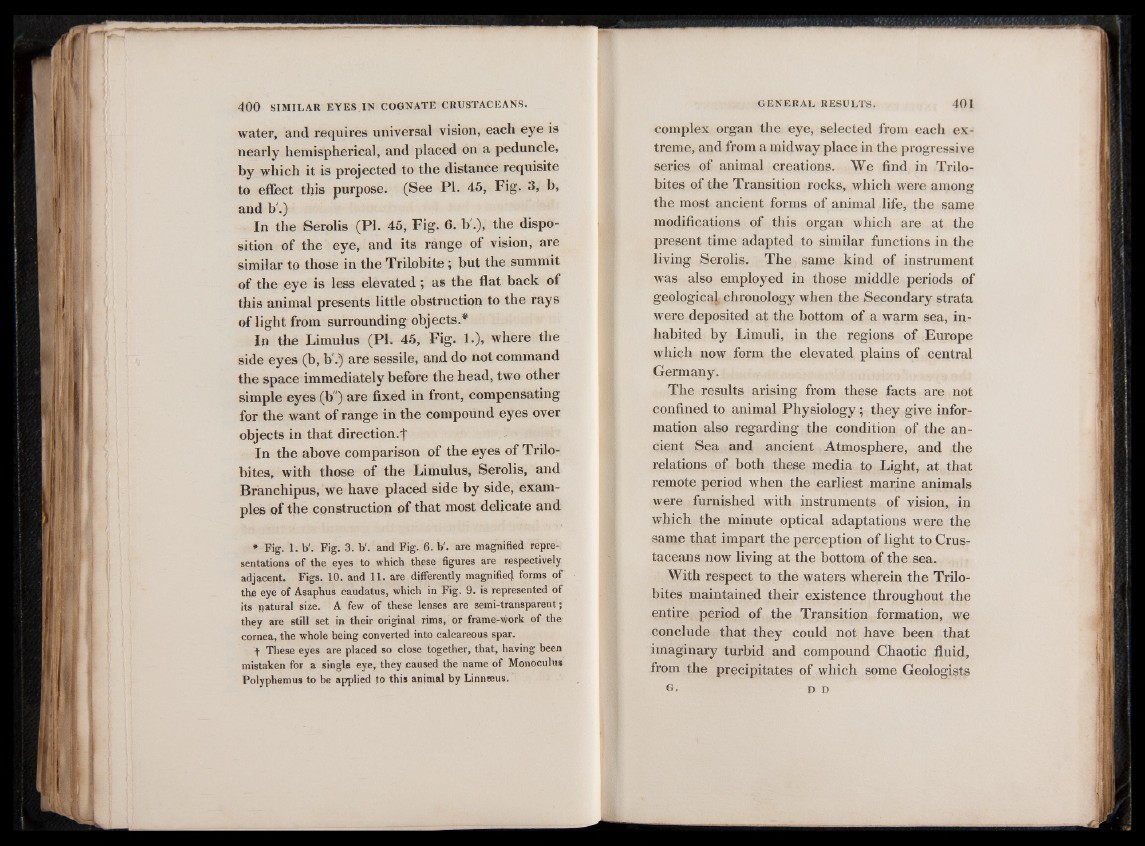
water, and requires universal vision, each eye is
nearly hemispherical, and placed on a peduncle,
by which it is projected to the distance requisite
to effect this purpose. (See PI. 45, Fig. 3, b,
and b'.)
In the Serolis (PI. 45, Fig. 6. b'.), the disposition
of the eye, and its range of vision, are
similar to those in the Trilobite; but the summit
of the eye is less elevated ; as the flat back of
this animal presents little obstruction to the rays
of light from surrounding objects.*
In the Limulus (PI. 45, Fig. 1.), where the
side eyes (b, b .) are sessile, and do not command
the space immediately before the head, two other
simple eyes (b”) are fixed in front, compensating
for the want of range in the compound eyes over
objects in that direction.f
In the above comparison of the eyes of Trilo-
bites, with those of the Limulus, Serolis, and
Branchipus, we have placed side by side, examples
of the construction of that most delicate and
* Fig. I. b'. Fig. 3. b'. and Fig. 6. b'. are magnified representations
of the eyes to which these figures are respectively
adjacent. Figs. 10. and 11. are differently magnified forms off
the eye of Asaphus caudatus, which in Fig. 9. is represented of
its natural size. A few of these lenses are semi-transparent;
they are still set in their original rims, or frame-work of the
cornea, the whole being converted into calcareous spar.
f These eyes are placed so close together, that, having been
mistaken for a single eye, they caused the name of Monoculus
Polyphemus to be applied to this animal by Linnseus.
complex organ the eye, selected from each extreme,
and from a midway place in the progressive
series of animal creations. We find in Trilo-
bites of the Transition rocks, which were among
the most ancient forms of animal life, the same
modifications of this organ which are at the
present time adapted to similar functions in the
living Serolis. The same kind of instrument
was also employed in those middle periods of
geological chronology when the Secondary strata
were deposited at the bottom of a warm sea, inhabited
by Limuli, in the regions of Europe
which now form the elevated plains of central
Germany.
The results arising from these facts are not
confined to animal Physiology ; they give information
also regarding the condition of the ancient
Sea and ancient Atmosphere, and the
relations of both these media to Light, at that
remote period when the earliest marine animals
were furnished with instruments of vision, in
which the minute optical adaptations were the
same that impart the perception of light to Crustaceans
now living at the bottom of the sea.
With respect to the waters wherein the Trilo-
bites maintained their existence throughout the
entire period of the Transition formation, we
conclude that they could not have been that
imaginary turbid and compound Chaotic fluid,
from the precipitates of which some Geologists
G, d n